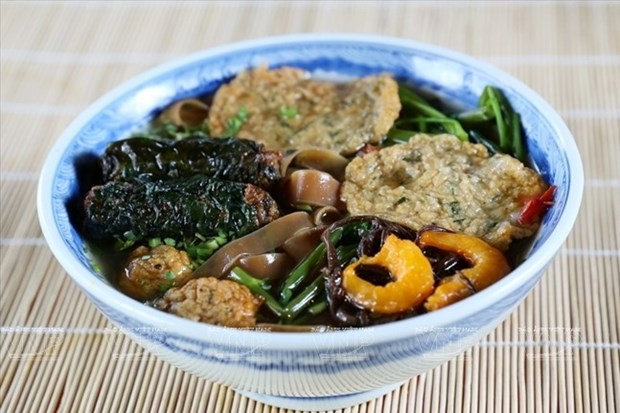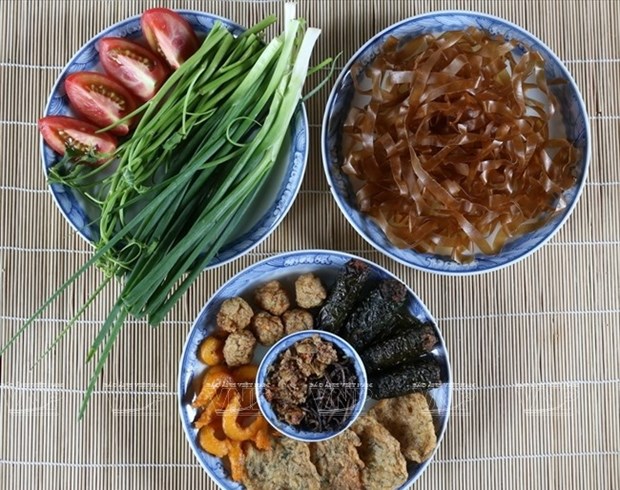When poet Nguyễn Thụy Kha, a Hải Phòng native, penned these verses, he was speaking for all the people of the port city who never fail to get nostalgic for this particular dish when they are away from home.
Returning
to Hải Phòng
to
have a bowl of canh bánh đa
Dearly
missing Cát Dài
Waiting for Cát Cụt

Hải Phòng has three villages with a 700-year history of making bánh đa. Hải Phòng’s bánh đa strip is wider than the normal noodle and is either white or dark brown. – Photo langvietonline.vn
The
canh bánh đa that the poet wrote
about is a noodle soup, but the noodles are very different from what is found
elsewhere in the country, and the dish’s flavours are particular to the port
city, too.
“Hải
Phòng food is in the middle range: not too sour, spicy, salty or sweet. Hải
Phòng cooks are not very meticulous in their presentation, like in the royal Huế
cuisine, for example; they pay more attention to the freshness of the
ingredients, especially seafood and river-food,” said Đào Thị Thanh Mai, a
culture and tourism lecturer at a private university in the port town.
“Delicacies
of Hải Phòng are often associated with seafood and river-food like fish, crab
and shrimp. And bánh đa cua has been the dish that has been attached with the
memory of Hải Phòng natives for long.”
The
dish features bánh đa (locally-made
flat rice noodle), crab meat, pork bones-based broth and vegetables. It is the
city’s pride, just as phở is to
Hanoians.
If
phở represents the delicateness of Hà
Nội cooks and food connoiseurs, bánh đa
cua can be said to be an expression and demonstration of traits of people
from Hải Phòng – sharp, bold and frank.
Bánh đa cua can be found in any street of the
port city and can be had at any time of the day, from dawn to midnight, said
Nguyễn Hoài Phương, a resident of the city’s Ngô Quyền Street.
“I
still remember the early mornings when I walked to school with my friends or
the wintery evenings when I sat in a street-food stall, breathing in the aroma
of fried minced dried onions and watching smoke swirl from the broth of bánh đa cua.
“As
far as I am concerned, a Hải Phòng woman is one who knows how to cook a bowl of
bánh đa cua. It is easy and always
satisfies. A full bowl can have mọc
(pork ball) or chả lá lốt (fried
minced pork wrapped in lá lốt
leaves), or chả cá (fried minced
fish). But to keep it simple, they just need to put the brown noodle in broth
with crab meat,” Phương said.
In
the old days, Tam Thuật alley off Cát Dài Street was one of the places that had
a large number of bánh đa cua
sellers.
Everyday
from 3 to 4 am, when the night lights were still on, residents could hear the
familiar sound of crab meat being pounded with a mortar and pestle, said Trần
Thị Bính, a Hải Phòng native.
Some
home cooks still use a mortar and pestle instead of using a blender to pound
the crabs when making the noodle soup, and they swear by the superior taste it
imparts.
Then
there are those who will use only the water spinach grown in the Đồ Sơn area,
which is best known for its crunchy taste.
Bánh đa cua now is available in different regions
of Việt Nam, but natives and many others claim that it is only in Hải Phòng
that one gets the must authentic taste of this specialty. They say that the
locally made rice noodles make a difference, and the difference makes this dish
specific to Hải Phòng.
Hải
Phòng has three villages – Lạng Côn, Hỗ and Dư Hàng Kênh – that have a 700-year
history of making this noodle.
Hải
Phòng’s bánh đa strip, white or dark
brown, is wider than the normal noodle, carries a strong fragrance of rice and
has a chewy taste. To make bánh đa cua,
Hải Phòng people will use fresh bánh đa,
dipping in hot water and then putting it in the broth. Cooks in other regions
use dry bánh đa instead and soak it
in cool water for several minutes before putting it in the broth.
Royal approval
No
discussion of any crab dish in the country is complete without mentioning the
crab broth.
The
broth is not particular to any locality, and it has its roots in rural areas,
but it has gone from humble beginnings to receive royal approval.
“When
I was small, life was very difficult. Those that had corn and sweet potato for
their daily meal were considered wealthy. Most families experienced hunger, and
meat was an unaffordable luxury. My friends and I would go often to the rice
fields and catch crabs to supplement our meager meals,” said Nguyễn Văn Thành
of Nam Định Province.
“Being
away from my rural hometown for a long time, crab broth is the thing that I
always miss the most. For me, it is linked to my childhood, my mother, the best
cook, and the countryside,” Thành said.
It
is said that King Lê Hiến Tông (1461-1504) once visited his master teacher,
Nguyễn Bảo, in Châu Khê village, Hải Dương Province. The teacher invited his
royal student to have a meal with him. It was simple fare with crab broth made
in a rural kitchen, something that could not be found in the palace. The king
told his teacher the crab broth was tastier than any other dish.
Later,
the king missed the broth, and locals began offering crabs to the royal palace.
Since then, there is a folk saying that goes:
Canh cua nấu cải thêm
gừng
Xưa nay vua chúa đã từng khen ngon
or
Crab broth cooked
with canola and ginger
Has for long been
praised by the king.
These
days, even after considerable improvements in living standards, crab broth
remains a favourite for many. It is cooked with many different vegetables
including rau ngót (star gooseberry),
rau cải (canola), bầu (gourd) or hoa thiên lý (cowslip creeper flowers).

Healthy greens: Crab broth is often cooked with different kinds of vegetables including star gooseberry, canola, gourd or cowslip creeper flower. – Photo giadinh.net

A bit of everything: Bánh đa cua has for long been Hải Phòng City’s inconic dish. — Photo Việt Nam Pictorial

The ensemble: Bánh đa cua features bánh đa (locally-made rice noodle), crab meat, pork bone-based broth and vegetables. — Photo Việt Nam Pictorial
Bánh đa cua can be
found at:
Hải Phòng:
26
Kỳ Đồng Street
124
Nguyễn Đức Cảnh Street
60
Lương Khánh Thiện Street
57
Cầu Đất Street
135
Lam Sơn Street
Hà Nội
111
Triệu Việt Vương Street
8
Hàng Đồng Street
59A
Phùng Hưng Street
87
Lý Thường Kiệt Street
By Hong Van/ VNS